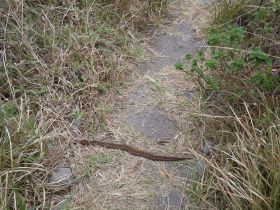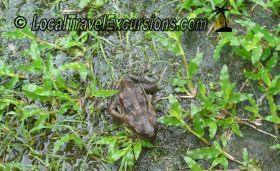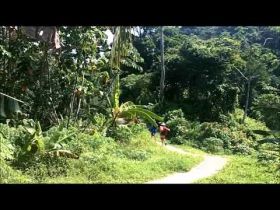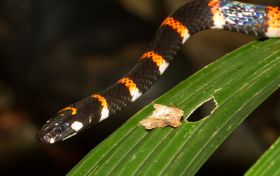Are there poisonous reptiles, snakes and insects, and dangerous animals in Panama?
Louis Seldon

Fer-de-Lance, poisonous snake in Panama
Are there poisonous reptiles, snakes and insects, and dangerous animals in Panama? Yes, there are some. At the top of the list is the Fer-de-Lance. Know what to do if you are bitten by one.


Fer-de-Lance, poisonous snake in Panama
Are there poisonous reptiles, snakes and insects, and dangerous animals in Panama? Yes, there are some. At the top of the list is the Fer-de-Lance. Know what to do if you are bitten by one.

.jpg)
Posted April 13, 2013
Col Davis Stevenson RET
Posted April 16, 2013
James David Audlin - Editores Volcán Barú

Posted May 26, 2013
Alan Filliger - Alana la Casa del Arte
Posted October 16, 2013
Lourdes Townshend
Posted October 17, 2013
Terry Little - GEM Charters and Terry Little Construction
Posted November 24, 2013
Nelson Vega
Posted November 26, 2013
Dennis Dean Smith - DennisDeanSmith
Posted January 20, 2014
Dennis Dean Smith - DennisDeanSmith
Africanized Bee Activity is Up in Panama
As in any country, there are poisonous reptiles, snakes and insects in Panama. The latest .jpg) insects making the news are the Africanized – or African – bees. Before we go into the statistics, let's get some facts straight.
insects making the news are the Africanized – or African – bees. Before we go into the statistics, let's get some facts straight.
As opposed to what you might read or see in the movies, African bees are not that much more deadly than other honey makers. What characterizes them is they tend to be more aggressive in protecting...
Africanized Bee Activity is Up in Panama
As in any country, there are poisonous reptiles, snakes and insects in Panama. The latest .jpg) insects making the news are the Africanized – or African – bees. Before we go into the statistics, let's get some facts straight.
insects making the news are the Africanized – or African – bees. Before we go into the statistics, let's get some facts straight.
As opposed to what you might read or see in the movies, African bees are not that much more deadly than other honey makers. What characterizes them is they tend to be more aggressive in protecting their territory and may do so up to 100 feet away if they feel threatened (noise, heat, intrusion, whatever). African bees also tend to swarm more than other species. The danger from a sting comes if you are allergic. Symptoms can include skin burning and itching, swelling or rash, nausea, shock - or in extreme cases, unconsciousness or even death. This of course requires a doctor. Otherwise treat a sting like you would any other.
Now for some statistics. Africanized bee sting activity in Panama is monitored by the Directorate of Operations of the Fire Department of Panama (CBP). Spokesmen have reported that there were 645 confirmed cases in January. 158 direct medical visits were attributed. The CBP doesn't track deaths directly attributed to the stings as it is not permitted to. (Who knows why?)
The areas that seem to be favorites are Los Santos and Panama Provinces. In the Panama City area, it's Alcalde Diaz, the (former) Canal Zone areas, Juan Diaz and Howard. Bee activity increases in Panama's dry season from mid-December to mid-April.
Should you panic? No. Problems with bees in Panama are rare. Most residents report that the bees they encounter on their properties or elsewhere are the tame variety. They just go on doing what normal bees do. Honey anyone?
Note: In another insect answer, we talked about the Dengue mosquito issue under the question, "In Panama, do I have to worry about malaria, yellow fever and other diseases we don't generally have in North America?"
Posted February 17, 2014
Mark Hurt
Posted July 5, 2014
Philip McGuigan - Chiriqui United, an Association of the leading humanitarian organizations in the Chiriqui Province of Panama
Posted July 6, 2014
Karen Walter - Local Travel Excursions
 As others have commented here, yes there are poisonous animals in Panama to be concerned about. However, none really concern me as much as the bufo marinus (giant toad.) Typically brown and green with excessive warts, this toad is as dangerous to pets as it is ugly. Its venom is secreted from its glands which is exceptionally toxic. If your pet licks, bites or eats this amphibian, it most likely will become sick and may die if not treated quickly. Found in...
As others have commented here, yes there are poisonous animals in Panama to be concerned about. However, none really concern me as much as the bufo marinus (giant toad.) Typically brown and green with excessive warts, this toad is as dangerous to pets as it is ugly. Its venom is secreted from its glands which is exceptionally toxic. If your pet licks, bites or eats this amphibian, it most likely will become sick and may die if not treated quickly. Found in... As others have commented here, yes there are poisonous animals in Panama to be concerned about. However, none really concern me as much as the bufo marinus (giant toad.) Typically brown and green with excessive warts, this toad is as dangerous to pets as it is ugly. Its venom is secreted from its glands which is exceptionally toxic. If your pet licks, bites or eats this amphibian, it most likely will become sick and may die if not treated quickly. Found in tropical climates, this frog is known for its high reproduction rate, large size (up to three pounds) and detrimental effects. As a pet owner, I now know that these creatures come out at night and are more present during and after the rain, and are attracted to light. In Panama, pet owners should check with their vet to make sure they are aware of this danger and how to treat their pet should they ingest any venom. Your vet will tell you the warning signs and possibly give you medication to administer should you encounter this situation. The first thing to do is wipe out the pets mouth with a wet rag, continuously. (Try not to flush the mouth with water as this will encourage the swallowing of the toxin.) Some vets may advise you to administer a small dose of hydrogen peroxide to induce vomiting. Be proactive. Seek the advice of your vet before you or your pet encounters this pest.
As others have commented here, yes there are poisonous animals in Panama to be concerned about. However, none really concern me as much as the bufo marinus (giant toad.) Typically brown and green with excessive warts, this toad is as dangerous to pets as it is ugly. Its venom is secreted from its glands which is exceptionally toxic. If your pet licks, bites or eats this amphibian, it most likely will become sick and may die if not treated quickly. Found in tropical climates, this frog is known for its high reproduction rate, large size (up to three pounds) and detrimental effects. As a pet owner, I now know that these creatures come out at night and are more present during and after the rain, and are attracted to light. In Panama, pet owners should check with their vet to make sure they are aware of this danger and how to treat their pet should they ingest any venom. Your vet will tell you the warning signs and possibly give you medication to administer should you encounter this situation. The first thing to do is wipe out the pets mouth with a wet rag, continuously. (Try not to flush the mouth with water as this will encourage the swallowing of the toxin.) Some vets may advise you to administer a small dose of hydrogen peroxide to induce vomiting. Be proactive. Seek the advice of your vet before you or your pet encounters this pest. Posted November 16, 2014
Mirhanna Sandoya - Lucero Homes Golf & Country Club
 There are dangerous animals in Panama. We have snakes and scorpions. Panama is home to a snake species called the “X” which is one of the most poisonous snakes in Latin America. It’s called the X because it’s black and it has little x’s on its back. If you get bitten by the X, you need to rush to the hospital and let them know that you were bitten by one. ,Then they will stabilize you and you’ll be okay. You will survive, but only if you get...
There are dangerous animals in Panama. We have snakes and scorpions. Panama is home to a snake species called the “X” which is one of the most poisonous snakes in Latin America. It’s called the X because it’s black and it has little x’s on its back. If you get bitten by the X, you need to rush to the hospital and let them know that you were bitten by one. ,Then they will stabilize you and you’ll be okay. You will survive, but only if you get... There are dangerous animals in Panama. We have snakes and scorpions. Panama is home to a snake species called the “X” which is one of the most poisonous snakes in Latin America. It’s called the X because it’s black and it has little x’s on its back. If you get bitten by the X, you need to rush to the hospital and let them know that you were bitten by one. ,Then they will stabilize you and you’ll be okay. You will survive, but only if you get immediate attention.
There are dangerous animals in Panama. We have snakes and scorpions. Panama is home to a snake species called the “X” which is one of the most poisonous snakes in Latin America. It’s called the X because it’s black and it has little x’s on its back. If you get bitten by the X, you need to rush to the hospital and let them know that you were bitten by one. ,Then they will stabilize you and you’ll be okay. You will survive, but only if you get immediate attention. Posted December 30, 2016
Keith Darby
 "Yes" is the definite answer.
"Yes" is the definite answer.  "Yes" is the definite answer.
"Yes" is the definite answer. Posted January 8, 2017
Ron Hunter - Finca Cazador
 There certainly are poisonous snakes and insects here in the Panamanian province of Chiriquí (where Boquete and Vulcan is located) and in the entirety of Central America. However, the frequency of contact that I have had with poisonous snakes and insects in the Sonoran Desert in Arizona (where I’m from) was far greater than here in Chiriquí.
There certainly are poisonous snakes and insects here in the Panamanian province of Chiriquí (where Boquete and Vulcan is located) and in the entirety of Central America. However, the frequency of contact that I have had with poisonous snakes and insects in the Sonoran Desert in Arizona (where I’m from) was far greater than here in Chiriquí.  There certainly are poisonous snakes and insects here in the Panamanian province of Chiriquí (where Boquete and Vulcan is located) and in the entirety of Central America. However, the frequency of contact that I have had with poisonous snakes and insects in the Sonoran Desert in Arizona (where I’m from) was far greater than here in Chiriquí.
There certainly are poisonous snakes and insects here in the Panamanian province of Chiriquí (where Boquete and Vulcan is located) and in the entirety of Central America. However, the frequency of contact that I have had with poisonous snakes and insects in the Sonoran Desert in Arizona (where I’m from) was far greater than here in Chiriquí. Posted February 20, 2017
John Vanover
Posted June 17, 2018


